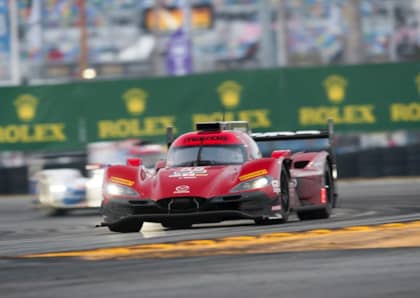Renault Cup Racing: The IMSA Racing Series Time Forgot
With French-made automobiles eyeing a return to the United States, it's instructive to look back on a time when Gallic brands were doing roughly the same thing as their Swedish counterparts on the American car scene: unusual choices made by free-thinkers willing to experiment with a vehicle no one else on their block had parked in their own driveway.
The early-to-mid-'80s were the last hurrah for automakers like Renault and Peugeot (with Citroen having officially abandoned the continent in 1974), and while their efforts were occasionally inspired (the Le Car), they were also at times more than a little confused. Such is the case with the Renault Alliance, the model that replaced the lovable oddball Le Car in 1983.
The Alliance was a more traditional, box-look sedan/coupe (with a hatchback model named the Encore) family of economy-minded commuters that was produced in partnership with another ill-fated brand. In fact, despite its Renault badge, the Alliance was built entirely by American Motors Corporation at its facility in Wisconsin, and was the fruit of a complicated financial lifeline extended to AMC by Renault a few years earlier, one that would lead to the French company to a controlling interest in the organization by the beginning of the 1980s.
Initially making use of the same 1.4L, 64hp four-cylinder engine that had been found in the Le Car, both the Alliance and the Encore were far from what one would consider a sporty ride today. Yet, almost immediately upon their introduction each would be featured in a bi-coastal, largely-forgotten, multi-year, single-marque racing series sanctioned by the International Motor Sports Association (IMSA).
Showroom Stock Success
The Renault Cup sprang from the desire to create a showroom stock series that would be cheap enough to attract an enormous number of competitors and create huge fields of cars, with the hope being that all that on-track traffic would lead to entertaining grassroots racing. Bundled in with this was a unique requirement to reduce travel to an absolute minimum so as to allow non-professional teams the ability to race every weekend without having to cross the country from one side to the other.

The entire concept was the brainchild of the Associated Road Racers (ARR), an East Coast organization with ties to the SCCA. After pitching a number of car companies on the idea, only one would bite: Renault, which was looking for a way to promote the performance version of the Le Car, the R5. As long as the ARR could guarantee 25 entries, Renault was willing to step up in a major way in terms of providing support to teams. Together, the automaker and the racing body were able to convince IMSA to come onboard, and by 1982 the series had hit the track.
Alliance Tag-In
With the departure of the Le Car from the scene the following year, Renault elected to keep things going by subbing in the Alliance and the Encore and renaming the series accordingly. The Renault Facom Cup was the name of the East Coast-only venture where the Encore hatch was the steed of choice, while the Renault Alliance Cup did battle on the West Coast (with five out of the six races held in California). As many as 50 cars at a time would take to the track to duke it out, making the show a fan favorite, and it was usually paired in support of the Camel GT series
At the end of the six-race season, the fields were combined in a battle royale at Watkins Glen in New York for '83 and '84, and then Road Atlanta for the truncated '85 schedule. Perhaps the most notable name to emerge from the Renault Cup was Parker Johnstone, who would go one to drive in IndyCar.
Although underpowered, the Alliance/Encore twins were lauded for their sub-2000 lbs curb weight and relatively balanced chassis. The showroom stock cars that competed in Facom and Alliance Cup were outfitted with a special suspension package that cost $1200 on top of the $5800 purchase price (at the time) of the vehicle itself.

The series ran all the way until 1985, and it sparked the decision by Renault's performance division (Renault Jeep Sport, or RJS) to also try its hand at the Champion Spark Plug Challenge, another IMSA series where the Alliance would go up against Hondas, Toyotas, Audis and VWs, as well as several entries from Detroit's Big Three. These particular Alliances found themselves in "Racing Stock" class, which afforded them better engines, transmissions and suspension setups than the showroom regulations allowed.
Still Out There
Surprisingly, it's not all that difficult to locate a Facom/Alliance Cup car on the secondhand market today. With roughly 200 produced in total (both Alliance and Encore combined), the sedan and hatch remained competitive in SCCA racing for decades past their star turn in their own series, and while parts continue to get more difficult to locate with each passing year, they are still serving in their intended role of providing a cheap entry into door-to-door racing.
Will these cars appreciate at the same level as their European racing contemporaries? It's hard to say. Single-marque racing continues to be popular (witness the fields at Spec Miata/E30/944 events) as a way to control costs while maximizing competition, but it would be a stretch to imagine anyone pining over a stripped-out Miata 25 years from now. Approached as a historical artifact, a Renault Cup car is a time capsule. Taken as a driver, it's a fun reminder of simpler, lighter times on the track. Purchased as an investment, however? Better have a backup plan.











